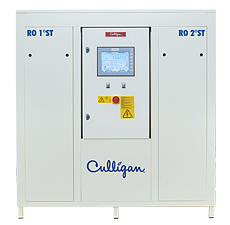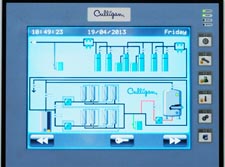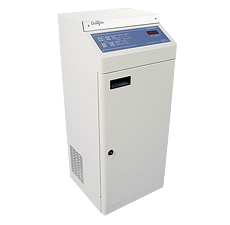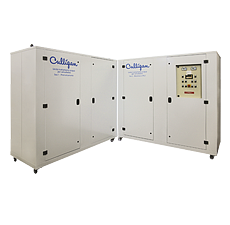Medical & Dialysis Water Treatment Systems
Culligan Reverse Osmosis Water Treatment for Hemodialysis Applications
The quality of water used in haemodialysis systems is a key requirement of successful dialysis treatment and must be available at all times.
With a Culligan Reverse Osmosis dialysis water treatment system you can be confident you are in safe hands.
30 YEARS EXPERIENCE – Culligan has over 30 years of experience of successfully treating water used in dialysis using medical certified reverse osmosis water treatment technology, with installations in hospitals throughout the world.
BEST TECHNOLOGY – Culligan has always been at the forefront of new water treatment technology and since the introduction of Culligan’s bi-osmosis (double pass in series) treatment concept to the dialysis market it is now an industry standard.
SERVICE WHEREVER YOU ARE – With service teams locally, and in over 90 countries around the wold, Culligan can respond to any customer request in the fastest time possible helping to ensure the dialysis centres water supply is always available 24 x 7.
ASSURANCE OF SAFETY – All of Culligan’s medical water treatment systems are certified Medical devices according to UNI EN ISO 13485NORMS.
Culligan Medical & Pharmaceutical Products
RO2 Bi-Osmosis System
For flows of up to 3600 l/h
The Culligan R.O.2 Bi-Osmosis is our most technologically advanced dialysis water treatment system ever.
With an intuitive “touch screen” user interface the R.O.2 is not only simple to use but thanks to the multiple fail safe systems within the unit, you can be assured of continuous water supply at all times.
The user can quickly and accurately monitor all key parameters such as water quality, operating pressure, flow rates and water consumption data thanks to advanced instrumentation and easy to interpret flow chart based displays together with powerful graphical trending tools.
Safety is ensured thanks to Culligan’s Bi-Osmosis system which ensures that in the unlikely event of a problem with one of the Reverse Osmosis systems the other will continue to run providing high quality safe water at all times.
As well as safety and reliability the Culligan R.O.2 haemodialysis water treatment system has been designed to minimize water consumption and be as energy efficient as possible, helping you to save money and be environmentally friendly at the same time.
Pre-treatment is provided external to the unit using the latest Culligan HE (High Efficiency) range of filters and softeners.
Top
SDS RO Single Dialysis System
Flow rate 80 l/h
Designed with individual patient dialysis care in mind; the SDS (Single Dialysis System) MD can deliver up to 80 l/h water production. Ideal for dialysis applications such as home dialysis, emergency services, acute patient care or for patients undergoing transplant procedures where space and mobility is critical. Each SDS unit is a fully contained dialysis water treatment system and includes pre-treatment in the form of filtration and de-chlorination followed by reverse osmosis and a break tank.
To aid with mobility the unit is mounted on wheels. The SDS has been designed with is extremely user-friendly thanks to a touch-control electronic panel. The SDS MD is equipped with:
Top
Dual Box – Integrated Pre-treatment and Bi-Osmosis Treatment System
The complete solution for Dialysis Water Treatment – the Dual Box system from Culligan is an integrated treatment system from raw water through to purified water. The system includes full pre-treatment (filtration, softening, dechlorination) and the Culligan Bi-osmosis technology. This complete treatment system is automatically controlled via touch screen PLC for ease of use. To aid with simple installation the units are contained within corrosion resistant steel cabinets, and simply require power, water inlet, outlet and drainage connections.
Top
Ongoing Support – Service and Maintenance
Culligan knows that peace of mind in the equipment used in all stages of patient care is crucial. We believe that the installation of the water treatment equipment is just the first stage of a long partnership of care.
With a presence in over 90 countries around the world Culligan are uniquely placed to provide after-sales care for your dialysis water treatment equipment wherever you are.
In addition to maintenance visits, consumables replacement and emergency maintenance response Culligan can also provide water treatment chemicals and hygiene services to provide you a holistic approach to water treatment in healthcare.
Find out how Culligan can provide a total water solution for your healthcare applications
Top
Frequently Asked Questions
Hemodialysis (also called haemodialysis) is method of mechanically cleansing the blood outside of the body, in order to remove various substances that would normally be cleared by the kidneys. Hemodialysis is used when an individual is in relative, or complete, kidney failure
During hemodialysis, blood from the dialysis patient flows into an artificial kidney, known as a dialyser, where it flows past a thin semi-permeable membrane whilst dialysate (isotonic salt solution) fluid flows past the other side of the membrane in a counter-current flow. Small molecules such as the metabolic waste molecules diffuse across this membrane, passing from the side of higher concentration to the side which is lower. In this way the metabolic waste products from the blood pass into the dialysate where it can be discarded to drain.
* Gale Encyclopedia of Medicine. Copyright 2008 The Gale Group, Inc. All rights reserved.
Dialysate is a mixture of purified water, and salt solution which can include sodium chloride, sodium bicarbonate or sodium acetate, calcium chloride, potassium chloride, and magnesium chloride. The dialysate is approximately 95% purified water.
The quality of water used in haemodialysis systems is crucially important, as not only is the patient’s blood and dialysate separated only by a thin semi-permeable membrane, haemodialysis patients are extremely vulnerable to contaminants in the water due to their inability to renally excrete any contaminants taken up from the distillate, they are also exposed to extremely large volumes of water. The estimated water intake of a healthy individual is 2 litres per day or 14 litres per week. By comparison, a haemodialysis patient may be exposed to 350 to 500 litres of water per week.






